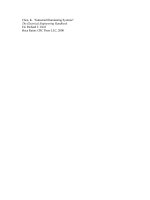Lecture Electrical Engineering: Lecture 21 - Dr. Nasim Zafar
Bạn đang xem bản rút gọn của tài liệu. Xem và tải ngay bản đầy đủ của tài liệu tại đây (880.45 KB, 41 trang )
COMSATS Institute of Information Technology
Virtual campus
Islamabad
Dr. Nasim Zafar
Electronics 1 EEE 231
Fall Semester – 2012
BJT as an Amplifier.
SmallSignal Operation and Equivalent Circuits:
Lecture No.
21
Nasim Zafar
2
References:
Ø Microelectronic Circuits:
Adel S. Sedra and Kenneth C. Smith.
Ø
Integrated Electronics :
Jacob Millman and Christos Halkias (McGrawHill).
Ø Introductory Electronic Devices and Circuits
Robert T. Paynter
Ø
Nasim Zafar
Electronic Devices :
3
Lecture No. 21
Reference:
Microelectronic Circuits:
Adel S. Sedra and Kenneth C. Smith.
Nasim Zafar
4
Introduction
CommonEmitter CharacteristicsI:
Ø
Ø
We had discussed Common Emitter CurrentVoltage
characteristic curves extensively to understand:
How the transistor operates as a linear signal amplifier
for the ac signals.
Ø
The basis for the amplifier application is the fact that
when
the BJT is operated in the activemode, it acts as the
voltagecontrolledcurrent source: Changes in the base
Nasim Zafar
5
Introduction
CommonEmitter CharacteristicsII:
Ø
Ø
Ø
Ø
Once these basics are understood we will understand:
How we can replace the transistor by a small acsignal
equivalent circuit.
How to derive a simple ac equivalent circuit from the
characteristic curves.
Some of the limitations of our simple equivalent circuit.
Nasim Zafar
6
The CommonEmitter Amplifier Circuit:
Nasim Zafar
7
CommonEmitter Amplifier Circuit:
Ø
Ø
The commonemitter amplifier exhibits high voltage and
current gain.
The output signal is 180º out of phase with the input.
Nasim Zafar
8
Characteristic Curves with DC Load Line:
Ø
Ø
Active Region:
Qpoint, and current gain.
Ø
Point A corresponds to the positive peak.
Ø
Point B corresponds to the negative peak.
Nasim Zafar
9
Summary
Common Emitter Amplifiers:
q
In Cutoff:
–
q
In Saturation:
–
q
All currents are zero and VCE = VCC
IB big enough to produce IC(sat) βIB
Using Kirchhoff’s Voltage Law through the ground
loop:
–
VCC = VCE(sat) + IC(sat)RC
–
but VCE(sat) is very small (few tenths), so
–
IC(sat) VCC/RC
Nasim Zafar
10
Small Signal Operation:
q
The Amplifier Circuits are Biased Such That:
Ø
Ø
Ø
Transistor amplifier is biased at its QPoint.
and a small voltage signal vi is superimposed on the dc
bias voltage VBE.
The resulting output signal vo appears superimposed on
the dc collector voltage VCE .
Nasim Zafar
11
Small Signal Operation:
The signal source vbe removed
for dcbiasanalysis.
Nasim Zafar
12
Small Signal Operation:
Ø
The amplifier output voltage vo (bias + signal) and output
current iC is given by:
=
Nasim Zafar
13
Small Signal Operation:
Ø
Thus the total output voltage vo is given by:
Nasim Zafar
14
Small Signal Operation:
The Signal Source, vbe, removed for DC Bias Conditions
IC
I S eVBE / VT
IE
IC /
IB
IC /
VCE
VCC
Nasim Zafar
I C RC
15
Amplifier Gain:
Ø
If changes in the operating currents and voltages are small,
then IC and VCE waveforms are undistorted replicas of the
input signal.
A small voltage change at the base causes a large voltage
change at the collector. The voltage gain is given by:
o
i
Ø
v (t )
Ø
Av (t )
“A” is the amplifier gain.
Nasim Zafar
16
Voltage Amplifiers:
Common Base PNP with an ac Signal
Ø
Voltage amplification can be obtained simply by passing the collector
current IC through a resistance RC.
The biasing of the junctions are:
BE is forward biased by VBB thus a small resistance
BC is reverse biased by VCC – and a large resistance
Since IB is small, IC IE
Nasim Zafar
17
Voltage Amplifiers:
Common Base PNP with an ac Signal
rE = internal ac emitter
resistance
IE = Vin/rE (Ohm’s Law)
VOut = ICRC
IERC
Vout
AV voltage gain
Vin
AV
I E RC
I E rE
RC
rE
, Since IB is small, IC IE
Recall the name – transfer resistor.
Nasim Zafar
18
Operating Limits:
q
There will be a limit on the dissipated power:
Ø PD(max) = VCEIC
Ø VCE and IC were the parameters plotted on the
characteristic curve.
•
•
If there is a voltage limit (VCE(max)), then we can
compute the IC that results
If there is a current limit (IC(max)), then we can
compute the VCE that results
Nasim Zafar
19
Operating LimitsExample:
Assume PD(max) = 0.5 W
VCE(max) = 20 V
IC(max) = 50 mA
Nasim Zafar
PD(ma VC
x)
E
0.5 W
IC
5 V 100 mA
10
50
15
33
20
25
20
The Collector Current and Transconductance:
Ø
Ø
Ø
Transconductance, for a bipolar device, is defined as the ratio
of the change in collector current to the change in base
voltage over a defined, arbitrarily small interval, on the
collector currentversusbase voltage curve.
The symbol for transconductance is gm. The unit is
thesiemens, the same unit that is used for directcurrent (DC)
conductance.
The transconductance (gm) of a transistor is a measure of
how well it converts a voltage signal into a current signal.
Transconductance, gm
Ø
Ø
It will be shown later that gm is one of the most important
parameters in integrated circuit design.
If dI represents a change in collector current caused by a
small change in base voltage dE, then the transconductance
is approximately:
gm = dI / dE
BJT Transconductance Curve:
NPN Transistor
Collector Current:
v
IC = IES eVBE/ VT
IC
Transconductance:
(slope of the curve)
v
gm = IC / VBE
IES = The reverse saturation current
of the BE Junction.
8 mA
6 mA
4 mA
VT = kT/q = 26 mV (@ T=300oK)
= the emission coefficient and is
usually ~1
2 mA
0.7 V
Nasim Zafar
VB
E
23
IC and gm
Since : vBE
vbe
I S e vBE / VT
Then : iC
I S e (VBE
VBE
vbe ) / VT
I S eVBE / VT e vbe / VT
I C e vbe / VT
For vbe
Then : iC
VT (which is realistic) :
vbe
IC 1
VT
Nasim Zafar
Observe: We arrive at this by
expressing ex as a Taylor
Series and truncating it after
the 2nd term.
24
Transconductance, gm
gm
dI C
dVBE
gm
1
VBE
I S exp
VT
VT
gm
IC
VT
d
VBE
I S exp
dVBE
VT









